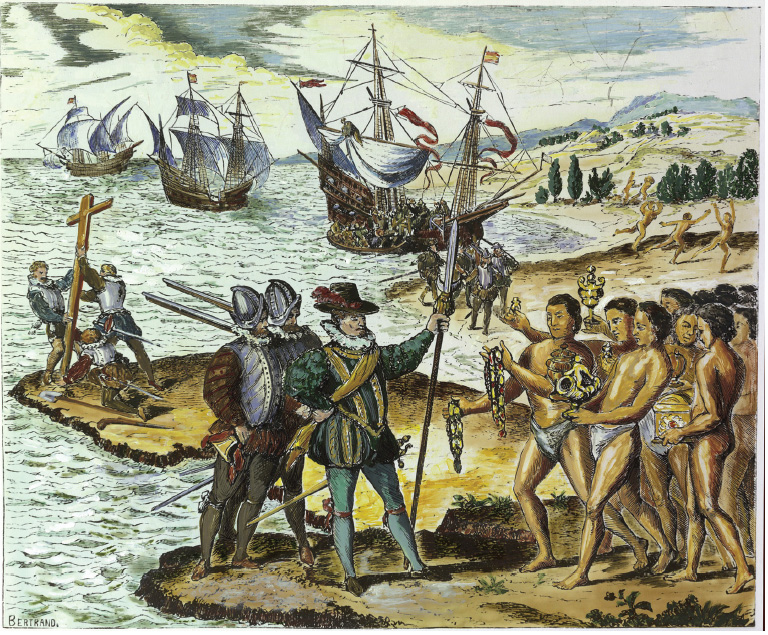The first meeting of Columbus and his Spanish explorers with the natives of the Caribbean was one to be remembered. Posterity has pictured this scene as one of happy explorers sharing food with the natives; but the truth of that first encounter, and its aftermath for the natives, was far from happy. Through the exchange, the natives received a number of diseases for which they had no immunities; and one of the largest demographic disasters the world has ever seen was the result. But the disease syphilis was also exchanged, between the New World and the Old World. The nature of this exchange of syphilis, though, is full of debate and speculation concerning its origins.

Syphilis was one of the most notable examples of New World diseases that traveled to the Old World in what historians now call the Columbian Exchange. There are two different theories for how syphilis was spread. The Columbian hypothesis claims that syphilis was spread by Columbus and his crew on their voyage back to the Old World. Once they contracted it from natives in the Americas, the crew then went back to the Old World. The evidence that supports this hypothesis is the assumption that Columbus’s crew members, once returned back to Spain, joined Spain’s war effort in Naples, exposing the disease to local prostitutes. Once exposed to syphilis, the disease was spread quite easily from the prostitutes to other soldiers and locals, thus increasing the spread of syphilis in the Old World. This explanation for the spread of syphilis is possible because some of Columbus’s crew did in fact join the war effort against Naples and most likely they did mingle with the locals there causing the spread of syphilis.1
The other theory, the Pre-Columbian hypothesis, was that syphilis had always been an Old World disease, but its spread was only exacerbated through the interaction of the natives and Europeans during the Columbian Exchange. This second theory is plausible since there is evidence of pre-Columbian Old World skeletons that show scars similar to syphilis scars. What this means is, since the skeletons from the Old World have scars and written accounts of symptoms similar to syphilis that pre-date the first exchange between Columbus and the Americas, syphilis could have possibly been an Old World disease. Now this theory of syphilis’ origin is a matter of syphilis being yet another disease that was spread from the explorers. Both of these hypotheses are plausible.2
Although these two theories for the origin of syphilis have been debated for decades, a less know third theory has emerged. This third theory suggests that syphilis was both an Old World and a New World disease. Syphilis is thought to “evolved simultaneously with human.”3 In other words, when the respectively different populations of humans evolved, the disease known as syphilis grew with the population in both hemispheres. This theory, though, is mostly unknown because of the two older and more established theories, which have dominated the discussions on syphilis’ origins. This third theory puts an interesting twist on this long debate.4
Through the exchange of syphilis, the lives of natives and explorers were changed in a drastic way. The picture of happy natives and explorers sharing food is one everyone has seen but the different narrative of the debate of syphilis’ origins is one many have not seen. The three theories of syphilis are all very real and possible, which is why the debate of syphilis is such a topic that can cause arguments. The debate over syphilis’ origins is one that will most likely be researched and hypothesized over for many years to come.
- Nathan Nunn and Nancy Qian, “The Columbian Exchange: A History of Disease, Food, and Ideas,” The Journal of Economic Perspectives 24, no. 2 (2010): 166-167. ↵
- Nathan Nunn and Nancy Qian, “The Columbian Exchange: A History of Disease, Food, and Ideas,” The Journal of Economic Perspectives 24, no. 2 (2010): 167. ↵
- Brenda J. Baker et al., “The Origin and Antiquity of Syphilis: Paleopathological Diagnosis and Interpretation and Comments and Reply,” Current Anthropology 29, no. 5 (1988): 703–706. ↵
- Brenda J. Baker et al., “The Origin and Antiquity of Syphilis: Paleopathological Diagnosis and Interpretation and Comments and Reply,” Current Anthropology 29, no. 5 (1988): 704. ↵



53 comments
Tyler Sleeter
Very interesting article with great information. I had heard of syphilis as the “French disease” when reading books about Tudor England, so I had just assumed it had been in Europe for ages. I also knew that early explorers had brought diseases to the natives they interacted with, causing many deaths among the natives that had never been exposed to these diseases. This is the first time I had heard of a disease that was spread from the newly discovered natives to Europe, and I am surprised that it is syphilis. I like how there are actually three hypotheses about the origin of syphilis, and I am sure that we may never know the actual origin.
Cameron Ramirez
I knew that when Columbus and his crew encountered the native people that many diseases were spread due to the natives not having an immune system that was not prepared for these Old World diseases. But, I did not think that syphilis was on the list of diseases. I learned in health class about STIs and their effects on the body. So I can only imagine those poor native people being affected by this disease/infection. Your article was well written, and it flowed well. I think it is important to call out what Columbus did to the native people because he and his crew took advantage of them. Overall, good work!
Crystalrose Quintero
I enjoyed reading how they posed what people thought the meeting between Columbus and Spanish explorers went and how it actually occurred. I also appreciated that they gave both hypotheses as to how syphilis may have spread and also gave reason as to why each might be true. I also liked that it circled back in conclusion to using what people think about natives and what really happened. It allows the article to be consistent and flow.
Megan Barnett
I like how you focused on the one disease of syphilis that was transferred and the theories behind where it originated. There was a lot that was transferred between the New and Old world, so in school we do not really go into detail about each and every one or even how things such as disease were transmitted. The first two theories seemed very likely to me, but not so much the third so I can see why it is not as popular.
Sam Vandenbrink
Very good article, not on one of the most existing topics in history but was still an interesting read! I remember learning about syphilis when I was in 7th-8th grade and didn’t remember much about it or its origin. This was a great article to spruce up my knowledge on one of the most detrimental diseases of the new world. Its sad how this effected the Indians because there bodies were not able to fight off the diseases.
Gabriela Serrato
I was very intrigued by this article. I never knew there was a debate over the origin of syphilis, I was always under the impression that these major diseases all came from the Old World and spread to the New World. It surprised me to read that there is such a controversy on what is true. Disease overall frightens me and I cannot imagine what these people endured without the medical knowledge that we have today. I am grateful for the advancements we have made, but I am even more eager for more to come.
Jennifer Pogue
Interesting article. I have never known that there was a debate over the origins of syphilis. Even though historians can not agree on its origins, I am sure they can all agree it is a horrible disease. Thankfully, our advances in technology and science have helped decrease the spread of syphilis. I had learned about how the Europeans had spread some diseases to the Natives, but the textbooks I read made it seem like the flu was spread. I had no idea it was this serious.
Johnanthony Hernandez
Interesting article, I always thought that syphilis was a disease that came from the Old World only. But to think that it could have come from the New World as well, or at least a different strain of it is very interesting. So now this article is making me think, where did this disease arise from and was it already in the New World before the Europeans arrived.
Sam Vandenbrink
Good article with very investing theories and hypothesis, I didn’t know much about syphilis or where it came from. But now I feel like I could explain it to someone just fine. the article really did a good job of telling how it spread throughout the old world and when it did so how it effected people. Spreading through prostitutes would not be my first guess of how the disease got around, but now that I know it seems like the most plausible explanation. Great article, very informative and well written.
Marissa Gonzalez
I found it interesting how there were several theories about the spreading of Syphilis. The interactions between the Old World and New World aided in spreading this disease quickly. It is sad to say that they had no immunization for Syphilis. This article was very good at describing on who was taking the “blame” for the initial spread of this disease due to so many theories about it. However, with more research, we are able to prevent the spreading of disease and help to better protect people from it. This article was very informative and seemed to have great research!